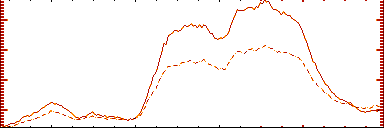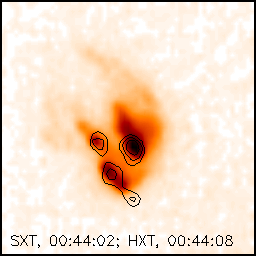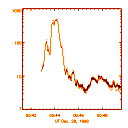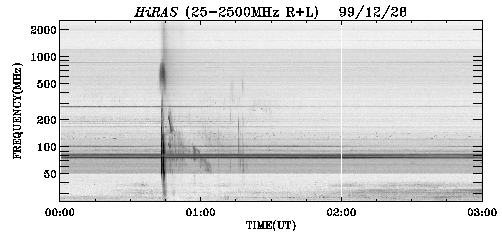 |
 |
Hard X-Ray Telescope scientist Sawa-san recently found a flare of almost record-breaking hardness, which took place at the end of last year: 01:00 UT on 28 December 1999. Flares at such times always delight our Japanese colleagues because the wee hours UT correspond to daytime for ground-based observatories in Japan. On this occasion, the observations showed that this unusual event was accompanied by a very fast eruption, which we'll discuss below. But this flare would be remarkable in any case.
 |
 |
The upper graph, on a linear scale, shows the counting rates in the lowest two HXT energy channels, nominally 15-23 keV and 23-33 keV. What is unique here is that the harder X-ray channel (the solid curve) has more counts than the softer channel. Converting the ratio approximately to a power-law slope using the known sensitivity of the HXT to radiation at various energies, we find that (at this level of analysis) it is indistinguishable from the magic slope -1.4 that would be produced by monoenergetic electrons at energies well above 33 keV. This is the nature of the bremsstrahlung spectrum, i.e., the energy distribution of radiation produced when accelerated electrons are slowed by collisions with the ambient solar atmosphere. A harder spectrum from this mechanism, acting alone, is impossible from a theoretical point of view.
The lower figure shows images at SXT's highest resolution. In all probability, they show flashes at footpoints of loops. The SXT images are too infrequent to follow the apparent motions as these sources flicker here and there, perhaps systematically in a way that can teach us about magnetic field restructuring and energy release. We expect (and confirm below) that the HXT images will show the same sources; better yet a full analysis of the HXT data will give us 0.5-sec sampling in time. A treasure trove!
First, let's overlay hard X-ray contours and soft X-ray images:

There. No problem, the flashes are broad-band so that both of telescopes can see them, or closely related things. This event re-opens the question of whether, in cases like this, SXT actually is imaging non-thermal hard X-rays to some extent.
Better yet, all of the Yohkoh alignment software and databases have survived Y2K very nicely, otherwise we would not get such good agreement.
Next let's roughly cross-calibrate the HXT photon energy, in spite of the fact that it is the best-calibrated hard X-ray photometric instrument ever built. So maybe we're calibrating BATSE here:

This plot compares the light curves for BATSE's 50-100 keV channel with HXT's 33-53 keV channel, where we have consistently found a good match in the past. We confirm this here, so nobody's calibrations have changed very much.
And just for completeness, here is some of the promised ground-based data about the eruption, i.e. the dynamic spectrum from the Japanese Hiraiso station:

Aficionados will see type III and type II radio emission (terms defined in the Glossary). See also the Nobeyama radioheliograph Web pages on this event. These are what we expect from a great eruptive event like this, but we've gone on too long and will postpone that part of the SXT show-and-tell until some future nugget. Just a hint - this eruption seems to be of a little-studied type. So, this nugget ends as an epic should begin, in medias res...
14-January-2000
H. Hudson (hudson@isass1.solar.isas.ac.jp)